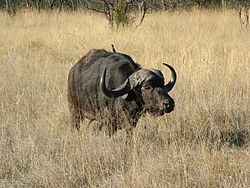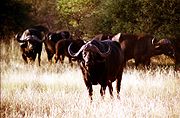
African buffalo
Background Information
SOS Children offer a complete download of this selection for schools for use on schools intranets. Before you decide about sponsoring a child, why not learn about different sponsorship charities first?
| African Buffalo | |
|---|---|
 |
|
| Conservation status | |
|
Conservation Dependent |
|
| Scientific classification | |
| Kingdom: | Animalia |
| Phylum: | Chordata |
| Subphylum: | Vertebrata |
| Class: | Mammalia |
| Order: | Artiodactyla |
| Family: | Bovidae |
| Subfamily: | Bovinae |
| Genus: | Syncerus Hodgson, 1847 |
| Binomial name | |
| Syncerus caffer ( Sparrman, 1779) |
|
| Subspecies | |
|
S. c. caffer |
|
The African Buffalo or Cape Buffalo (Syncerus caffer) is a bovid from the family of the Bovidae. It is up to 1.7 meters high, 3.4 meters long. Savannah type buffaloes weigh 500-900 kg, with only males, normally larger than females, reaching the upper weight range. Forest type buffaloes are only half that size.The African Buffalo is not closely related to the slightly larger Wild Asian Water Buffalo, but its ancestry remains unclear. Owing to its unpredictable nature which makes it highly dangerous to humans, it has not been domesticated, unlike its Asian counterpart, the Domestic Asian Water Buffalo.
Ecology
The African buffalo is one of the most successful grazers in Africa. It lives in swamps, floodplains as well as mopane grasslands and forests of the major mountains of Africa. Buffalo can be found from the highest mountains to sea level areas, and prefer habitat with dense cover such as reeds and thickets. Herds have also been found in open woodland and grassland.
Like the Plains zebra, the Buffalo can subsist on tall, coarse grasses. Herds of buffalo will reduce grass level to the height that is preferred by selective grazers. When feeding, the buffalo makes use of its tongue and wide incisor row to eat grass more quickly than other African herbivores. Buffalo do not stay on trampled or depleted areas for long.
Other than humans, African buffalo have few predators and are capable of defending themselves against (and sometimes killing) lions. Lions do kill and eat buffalo regularly, but it typically takes multiple lions to bring down a single adult buffalo; only large male lions have been known to take down adult buffalo on their own. The Nile Crocodile will typically attack only old solitary animals and young calves. The leopard and spotted hyena are a threat only to newborn calves, though spotted hyenas have been recorded to kill full grown bulls on occasion.
Social behaviour
Herd size is highly variable. The basic herds consist of related females, and their offspring, in an almost linear dominance hierarchy. The basic herds are surrounded by sub-herds of bachelor males, high-ranking males and females, and old or invalid animals. The young males keep their distance from the dominant bull, who is recognizable by the thickness of his horns.
Adult bulls will spar in play, dominance interactions or actual fights. A bull will approach another slowing with his horns down and wait for the other bull do the same thing. When sparring the bulls twist their horns from side to side. If the sparring is for play the bulls may rub each other's faces and bodies during the sparring session. Actual fights are violent but rare and brief. Calves may also spar in play but adult females rarely spar at all.
When chased by predators a herd will stick close together and make it hard for the predators to pick off one member. Calves are gathered in the middle. Buffalo will try to rescue a member who has been caught. A calf's distress call will get the attention of not only the mother but also the herd. Buffalo will engage in mobbing behaviour when fighting off predators. They have been recorded treeing lions for two hours, after the lions have killed a member of their group. Lion cubs can get killed and trampled.
Reproduction
Buffaloes mate and give birth strictly during the rainy seasons. Birth peak takes place early in the season while mating peaks later. A bull will closely guard a cow that comes into heat, while keeping other bulls at bay. This is difficult as cows are quite evasive and attract many males to the scene. By the time a cow is in full estrous only the most dominant bull in the herd/subherd is there.
Cows first calve at five years of age, after a gestation period of 11.5 months. Newly born calves remain hidden in vegetation for the first few weeks while being nursed occasionally by the mother before joining the main herd. Calves are held in the centre of the herd for safety. The maternal bond between mother and calf last longer than in most bovinds. However when a new calf is born the bonding ends and the mother will keep her previous offspring out of the way with horn jabs. Neverthelss the yearling will still tag along for another year or so. Males leave their mothers when they are two years old and join the bachelor groups.
Attacks on humans
Known as one of the " big five" or "Black Death" in Africa, the African Buffalo is widely regarded as a very dangerous animal, as it gores and kills several people every year. Buffalo are sometimes reported to kill more people in Africa than any other animal, although the same claim is sometimes made of Hippopotamuses, Crocodiles or Bees. Buffalo are notorious among big game hunters as very dangerous animals, with wounded animals reported to ambush and attack pursuers.
Status
The current status of African cape buffalo is dependent on the existence of the animal's value to both trophy hunters and tourists, paving the way for conservation efforts through anti-poaching patrols, village crop damage payouts, and CAMPFIRE payback programs to local areas.
The current total number of cape buffalo is spread throughout non-desert Africa, from Egypt in the North to South Africa in the South. The cape buffalo are estimated to number around a million, but accurate counts are not possible with the lack of research funding in places like Sudan, Chad, Congo, and Benin. Most professional hunters, safari outfitters, and wildlife professionals believe the number to be only representing the actual Cape subspecies, and not counting the Nile, North-East, or Forest buffalo.




